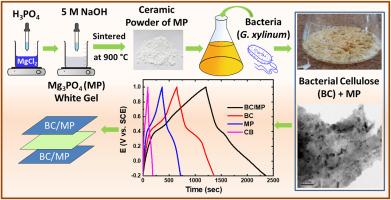In-situ synthesized magnesium phosphate/bacterial nanocellulose composite as a sustainable material for high-performance symmetric supercapacitors
IF 9.8
1区 材料科学
Q1 MATERIALS SCIENCE, COMPOSITES
引用次数: 0
Abstract
Electrochemical supercapacitors (ECSCs) are crucial for the energy storage sector, particularly in managing intermittent renewable energy sources. This work innovatively develops an environmentally friendly composite material of Mg3(PO4)2 (magnesium phosphate, MP) within bacterial cellulose (BC) using the Gluconacetobacter xylinum ATCC 10245 bacterial strain. Various characterization techniques, including XRD, FT-IR, TGA, and TEM, were used to evaluate the structural properties of the synthesized MP, BC, and magnesium phosphate/bacterial nanocellulose (BC-MP) composite. The electrochemical properties of the material were evaluated by cyclic voltammetry, galvanostatic charge/discharge, and electrochemical impedance spectroscopy in 0.5 M H2SO4. The BC-MP electrode was found to have a high specific capacitance of ≈2000 F/g at 2 A/g. Additionally, a symmetric supercapacitor device based on BC/MP electrodes showed outstanding energy (≈52 Wh/kg) and power densities (≈890 W/kg) at 1 A/g, as well as an excellent cycle life stability (100 % after 5000 cycles and ≈97 % after 7000 cycles) at 10 A/g. The remarkable performance of the BC/MP composite can be attributed to the high surface area of the BC and MP and their synergistic effect in increasing hydrophilicity and conductivity. This study highlights the potential of BC/MP composite as a promising electrode material for high-capacity electrochemical supercapacitors.

原位合成磷酸镁/细菌纳米纤维素复合材料作为高性能对称超级电容器的可持续材料
电化学超级电容器(ECSCs)对于能源存储领域至关重要,特别是在管理间歇性可再生能源方面。本研究利用xylinum葡醋杆菌ATCC 10245菌株,在细菌纤维素(BC)中创新性地开发了一种环保型复合材料Mg3(PO4)2(磷酸镁,MP)。采用XRD、FT-IR、TGA和TEM等表征技术对合成的MP、BC和磷酸镁/细菌纳米纤维素(BC-MP)复合材料的结构性能进行了表征。采用循环伏安法、恒流充放电法和电化学阻抗法对材料在0.5 M H2SO4中的电化学性能进行了评价。BC-MP电极在2 a /g时具有≈2000 F/g的高比电容。此外,基于BC/MP电极的对称超级电容器器件在1 a /g下表现出出色的能量(≈52 Wh/kg)和功率密度(≈890 W/kg),以及在10 a /g下优异的循环寿命稳定性(5000次循环后100%,7000次循环后≈97%)。BC/MP复合材料的显著性能可归因于BC和MP的高表面积及其在提高亲水性和导电性方面的协同作用。该研究突出了BC/MP复合材料作为大容量电化学超级电容器电极材料的潜力。
本文章由计算机程序翻译,如有差异,请以英文原文为准。
求助全文
约1分钟内获得全文
求助全文
来源期刊

Composites Science and Technology
工程技术-材料科学:复合
CiteScore
16.20
自引率
9.90%
发文量
611
审稿时长
33 days
期刊介绍:
Composites Science and Technology publishes refereed original articles on the fundamental and applied science of engineering composites. The focus of this journal is on polymeric matrix composites with reinforcements/fillers ranging from nano- to macro-scale. CSTE encourages manuscripts reporting unique, innovative contributions to the physics, chemistry, materials science and applied mechanics aspects of advanced composites.
Besides traditional fiber reinforced composites, novel composites with significant potential for engineering applications are encouraged.
 求助内容:
求助内容: 应助结果提醒方式:
应助结果提醒方式:


